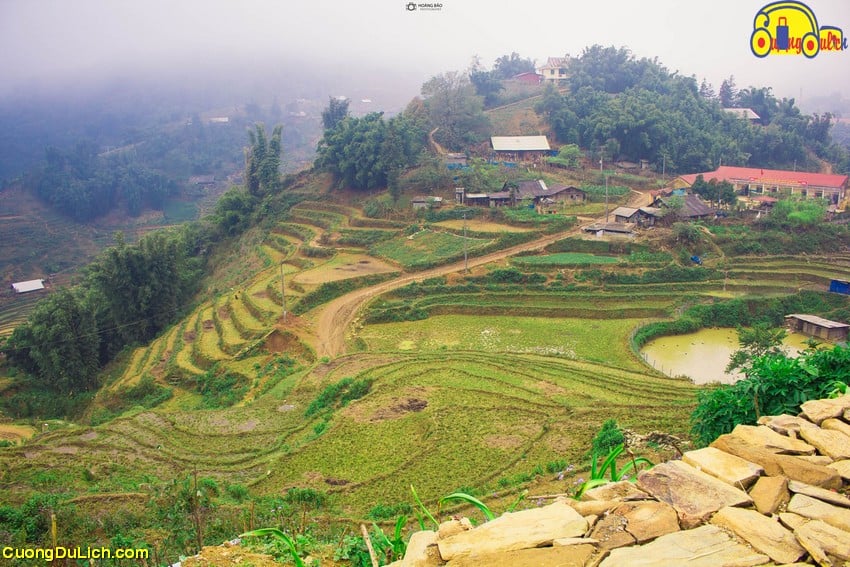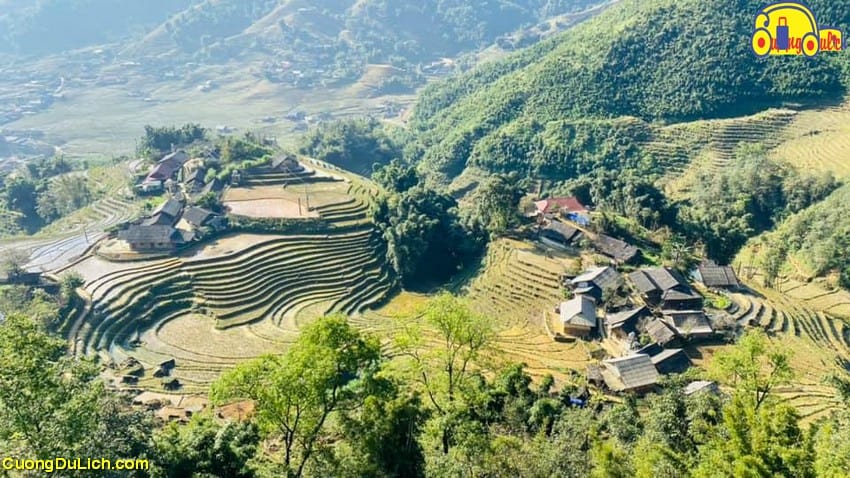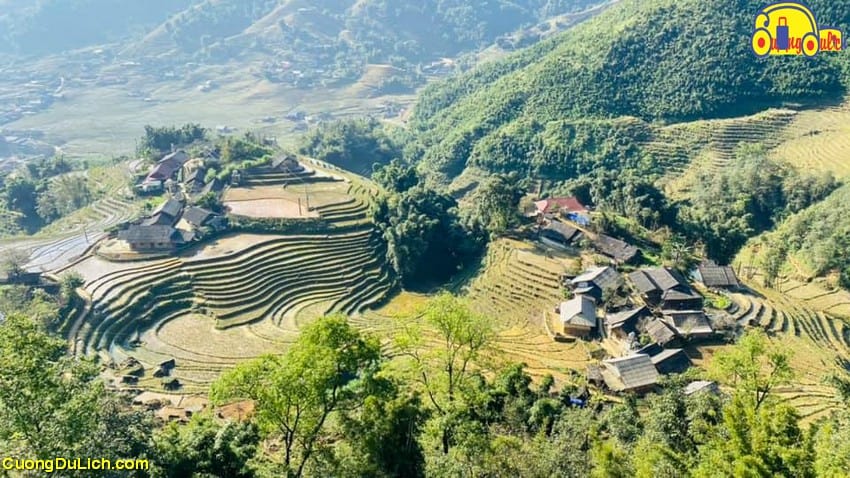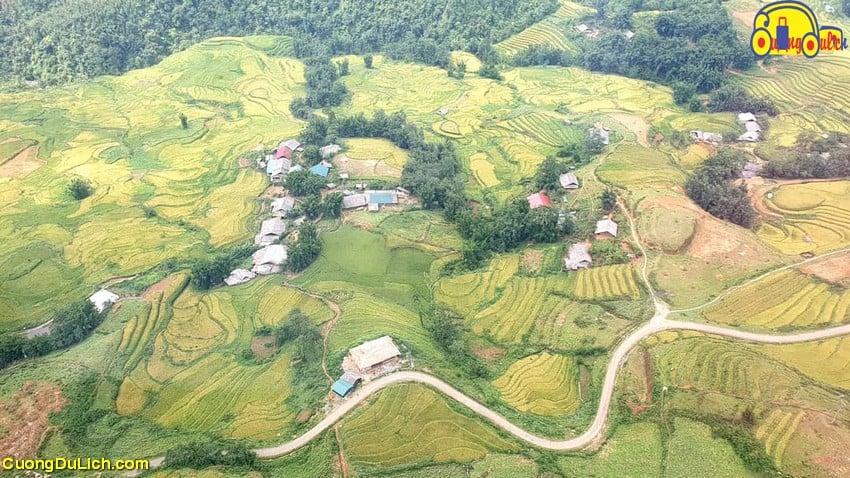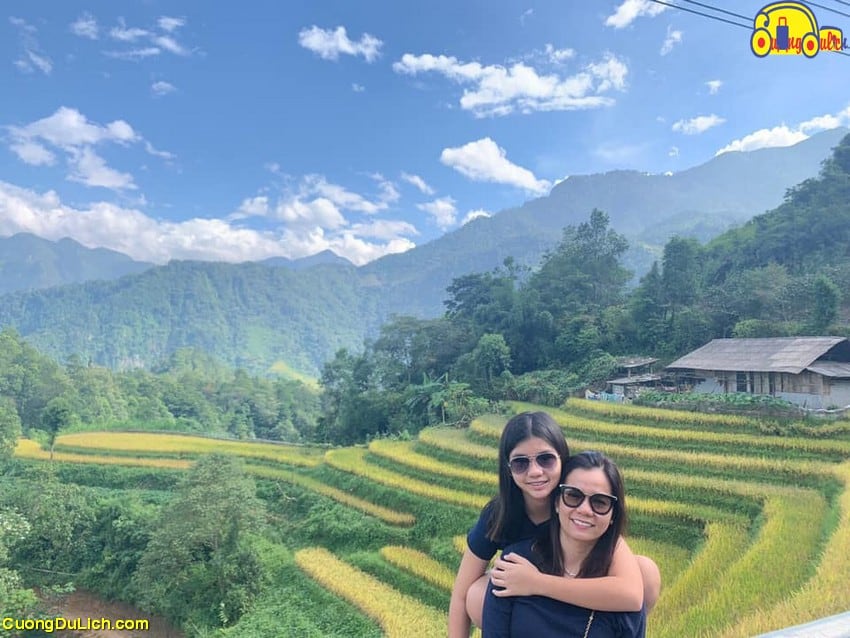When you travel to Sapa, what do you need? Not just wanting to have a few relaxing days off, not just wanting to breathe in the fresh mountain air, not just wanting to explore the life of the ethnic minorities in northern Vietnam, right? Because the villages in Sapa are an indispensable part of Sapa tourism, so tourists coming to Sapa also want to visit some famous tourist spots in those villages. Along with the beautiful and majestic scenery of the mountains and forests, the villages of the ethnic minorities here attract a large number of visitors to Sapa every year.
In Sapa, besides the Kinh ethnic group, there are 5 brotherly ethnic groups including the H’mong people, the largest community, followed by the Red Dao, Giay, Tay, and Xa Pho.
Let’s explore the 7 most beautiful ethnic villages that you must visit when traveling to Sapa with Cuong Travel
1. Cat Cat Village – the nearest village to the center of Sapa
Introduction to Cat Cat Village, Sapa
Cat Cat Village is a famous ethnic village and the most visited by Vietnamese tourists. Cat Cat Village is located in San Sa Ho commune, Sapa district, about 2km from the center of Sapa town to the village gate. You can choose to walk, combining with admiring the mountainous scenery and overlooking the entire village from above. Cat Cat Village is also a small village of the H’mong ethnic community.
In addition to the beautiful scenery with terraced fields and Muong Hoa stream, Cat Cat Village has built additional infrastructure to serve tourism such as small stone-paved roads through the village center, exhibition houses displaying artifacts and labor products of the people, preserving traditional handicrafts.
At the village center is where the hydroelectric plant built by the French on the Muong Hoa stream is located, now this place is where local cultural performances serve tourists daily.
On the way back, from the last stop of Cat Cat Village to the town is over 3km. After a long exploration of the village, the 3km return journey will make you quite tired, so if you are not in good health, you should ride a motorbike and park at the village gate (not allowed to ride inside the village).
Read more
Top 10 Must-Visit “Virtual Living” Corners at Cat Cat Village
REVEALED: Most Detailed Self-Guided Sapa Travel Guide Ever
10 Hottest Sapa Tourist Destinations – Save Now to Avoid Regrets
Cat Cat Village Sapa Entrance Fee
- Motorbike parking fee is 10k
- Entrance fee to Cat Cat Village is 50k/person.
- Ethnic costume rental price is 50k/person
There are many ethnic costume rental shops in front of the village gate, you can get yourself a set. There are also many other accessories that you can rent such as the ethnic people’s sunshade…
One more small note is when buying tickets, at the ticket counter, there are many maps available. You can take one for free and the map is very useful. It lists all the famous attractions in Cat Cat Village and provides directions – very useful
You should prepare some candies in your bag because on the way to visit the village, there are many ethnic children who will follow you. These children sell handmade items and invite you to buy, if you don’t want to buy, give them a candy and they will stop following you.
2. Ta Phin Village – Where the oldest things in Sapa are preserved
Introduction to Ta Phin Village, Sapa
Located about 14 km from Sapa town towards Lao Cai city, Ta Phin village is home to the Red Dao ethnic minority. Ta Phin village is situated in a valley surrounded by mountains, yet it is quite spacious and flat.
This place is famous for its medicinal bath leaves, creating the brand “Red Dao medicinal bath leaves”. When strolling around Sapa town, tourists will see many massage parlors offering medicinal leaf bath services originating from here.
It is important to note that when visiting the village, do not wear white unbleached linen, as it is the color of mourning. When the host offers water or alcohol, if you decline, it is advisable to politely explain so the host understands and is sympathetic. Only the master of ceremonies is allowed to place the bowl on the table to drive away evil spirits.
Today, Ta Phin village is one of the strongholds for homestay tourism. Besides visiting the village, ancient caves, tourists can experience medicinal leaf baths, buy brocade products, or enjoy local specialties served by restaurants here.
See more
NOTE 10 Important Tips When Going to Sapa Love Market
GUIDE Going on a 1-Day Trip to Sapa Where to Go and What to Do “RIGHT STANDARD”
[CRYING LAUGHING] When Traveling to SAPA
What does Ta Phin Village, Sapa have to offer?
Near Ta Phin village is Ta Phin cave, with an entrance about 5m high and 3m wide leading down into the ground. Inside the cave, visitors will see rock formations resembling a mother carrying a child, rocks resembling fairies, some looking like giant rice trays… In the widest part of the cave, stalactites hang down like twisted, undulating ribbons, shimmering in emerald green. Further in, there is a large rock lying slightly tilted, with chicken footprints engraved on the rock, and on the right peak of the rock, there are grooves resembling horse hooves. On the opposite rock face, French characters are carved with a hard object, still readable despite the dust of time covering them. Ta Phin cave holds many mysteries that need to be protected and preserved.
On National Highway 4D towards Lao Cai city, about 4 kilometers after leaving Sapa town, there is a fork in the road leading to a small asphalt road, where a toll booth is encountered. The entrance fee is 20,000 VND per person. Continuing for about another 18 kilometers will lead you to Ta Phin village.
At some points, the road winds along the hillside, with terraced rice fields on both sides in lush green, the fields hugging the hillside creating soft, flowing curves, smooth and gentle like ripples in the valley. Far at the horizon, on the rocky mountain slopes are patches of dark green cornfields. The picturesque scenery helps us forget the fearful feeling of this long and winding “painful road”!
3, Lao Chai Village – A picturesque mountainous landscape in Sapa
Introduction to Lao Chai Sapa
Ban Lao Chai is a village of the Black H’Mong ethnic group, located about 7-8 km southeast of Sapa town. Visitors can reach Ban Lao Chai from Sapa without spending too much time on transportation. When visiting Ban Lao Chai, tourists can get in touch and learn about the culture and customs of the ethnic minority people in the northern mountainous region. Lao Chai is a village consisting of three large hamlets with over 100 households of the Black H’Mong ethnic group.
Nestled against the majestic Hoang Lien Son mountain range, with the Muong Hoa stream flowing in front, along with vast terraced fields, Lao Chai is a village with a picturesque and charming landscape, one of the most beautiful in Sapa.
From the high point of the 8 km main road from Sapa town to the village, visitors can admire a panoramic view of Ban Lao Chai, with high mountains behind the village and facing the river. The H’Mong people in this hamlet make a living by cultivating rice in the lowlands near the foot of the valley. This is considered their main source of income besides growing corn on the mountainside behind the village.
What does Ban Lao Chai Sapa offer?
The Black H’Mong communities still retain many traditional customs, especially the custom of marriage. Most Black H’Mong families rely on farming, land, and income from selling woven goods at local markets. Only when buying livestock or household items do they need money, as most of their food is self-cultivated and raised. When visiting Ban Lao Chai, tourists will experience the culture, customs, and life of the Black H’Mong people and admire the terraced fields characteristic of the northern mountainous region.
4. Ban Ta Van
Introduction to Ta Van Sapa
Along with Cat Cat village, Ta Van Sapa is also a destination that young people love to explore. Ta Van is a small village in Ta Van commune, Sapa district, Lao Cai province. It is located about 10km from the center of Sapa town. There are no high-rise buildings, no city smoke, all Ta Van has is a simple and romantic landscape with a clear blue sky, terraced fields of ripe golden rice, rustic mud-walled houses, and small dirt roads lined with wildflowers on both sides. All of this creates a peaceful highland picture.
Passing through Lao Chai village, 3 km away is Ta Van village, the home of the Giay ethnic community. Situated in a valley with the Muong Hoa stream flowing through, the terraced fields here are also very beautiful. Together with Lao Chai, they form a common name for a tourist destination “Lao Chai – Ta Van,” visitors who visit Lao Chai must also visit Ta Van and vice versa.
Read more
Traveling to Sapa Alone is More Fun and Safe Than You Think
[Compilation] Top 10 Hotels and Resorts in Sapa.
Top 15 “Creepy” Specialty Dishes in the Northwest
What does Ta Van Sapa have to offer?
Ta Van is a village that has developed strong homestay tourism and has the most homestay accommodations for rent in Sapa. When visiting Ta Van, tourists can also stop here for lunch at local restaurants.
You can reach Ta Van Sapa by car or motorbike. However, the preferred mode of transportation for many Sapa tourists is motorbikes, as you can ride and enjoy the romantic scenery and breathe in the fresh air here. Since Ta Van mainly has small roads, larger vehicles may find it difficult to navigate. Rent a motorbike in the town center and ask directly for directions to Ta Van.
It’s hard to say what a trip to Ta Van Sapa will bring you. What you can be sure of is that it will be a journey to find peace. As mentioned, Ta Van does not have high-rise hotels, modern homestays, or magical check-in spots. Ta Van exudes a simple and untouched beauty. The houses here are often made of wood or mud. The household items are also made from wood. Minimally influenced by modern life, the people here make the most of everything nature has to offer.
5, Sin Chai Village
Introduction to Sin Chai, Sapa
One of the most special things about a trip to Sapa is the pristine beauty, colored by time, of the ancient villages. Most of the villages in Sapa maintain their rustic, simple charm, but the most poetic and rustic village is Sin Chai. After passing Cat Cat village for about 2 km, you will reach Sin Chai, which, despite being close to Sapa town, has not been commercialized as much as other villages. This is an ideal place for tourists who want to observe and learn about the lives of the local Black H’mong people.
Sin Chai village (also known as Xín Chải) is embraced by the Hoàng Liên Sơn mountain range, located at the foot of the mountain, creating a “very poetic” landscape amidst the pristine mountains and forests. As one of the largest villages in Sapa, Sin Chai is increasingly attracting the attention of many domestic and international tourists.
Learn more
Share Experience Climbing Ham Rong Mountain Sapa 2020
Detailed Review of Cat Cat Village Sapa – The Most Beautiful Village in the Northwest
Review of Fansipan Sapa with Detailed Guide from A – Z
What is special about Sin Chai, Sapa?What’s Special About Sin Chai, Sapa?
People often visit Sin Chai village during the rice harvest season, from September to October every year. At this time, the vast space is filled with the golden color of ripe rice, captivating visitors. Anyone who visits Sin Chai once will take away unforgettable memories.
The wooden houses, typical of the H’mong people, are situated right next to the small road that runs from the beginning to the end of the village, a road wide enough only for a motorcycle to pass. The terraced fields around the village may not be vast and magnificent, but they have their own unique beauty during the rice season.
When is the best season to visit Sapa? What is the ideal time to visit Sin Chai? It is difficult to give a definitive and complete answer, as everyone will have their own perception of Sapa. However, there are a few golden periods that many people talk about, such as May, June, September, and October.
6, Ban Ho
Introduction to Ban Ho Sapa
Located about 30 km from Sapa town in the same direction as the Lao Chai – Ta Van route, Ban Ho is a village of the Tay people, with a relatively small population compared to other ethnic groups. The village is situated in a small valley at the downstream of the Muong Hoa stream.
Ban Ho commune has a climate that is completely different from the rest of the province, with warm weather and a winter that is not as cold as in other villages. The center of Ban Ho is the Ban Den hamlet where the Muong Hoa and La Ve streams intersect, flowing gently.
What does Ban Ho Sapa offer?
The Muong Hoa stream with its beautiful landscape, the peaceful stream flowing around the traditional Tay villages, intertwined with the daily life of the people here, has created a picturesque and peaceful scenery. The La Ve stream cascades down from the high mountains into waterfalls with groups of fish dancing along the stream, creating a lively scene. Here, you can enjoy fishing and savoring excellent grilled fish right by the stream.
To reach the tourist village from the main road, visitors must pass through a winding and scenic route. The most interesting thing about visiting Ban Ho is experiencing a homestay in the typical stilt houses here, along with enjoying unique dishes and bathing in the stream, which should not be missed.
In addition to these two famous streams, Ban Ho also has many other small streams and waterfalls meandering around the village.
From the winding road leading to the village, with one side being towering mountains and the other side a deep abyss, in the distance at the end of the road is the shimmering yellow color from the terraced fields, nestled among the traditional houses of the Tay and Giay ethnic groups along both sides of the stream, creating a peaceful and heartwarming scene.
Walking around Ban Ho, you will witness how the local ethnic people weave brocade, listen and participate in unique singing and dancing performances.
7, Ban Y Linh Ho
Introduction to Ban Y Linh Ho Sapa
Sapa is not only known to tourists for many tourist destinations such as Ham Rong Mountain, Muong Hoa Valley… but also attracts visitors to explore the pristine beauty of Ban Y Linh Ho Sapa.
From Sapa town, about 3 km down to Lao Chai, stop at the slope area, the majestic beauty and the distinctive name of Y Linh Ho appear, attracting many tourists to explore when setting foot in this land of Sapa.
What does Ban Y Linh Ho Sapa offer?
Y Linh Ho is a commune with many small ethnic groups, living scattered on the mountainous terrain with high and steep mountains. With simple houses made of earth or bamboo, along with cornfields, rice fields on the steep hillsides.
Often not mentioned much, but Ban Y Linh Ho is very suitable for trekking tours. Standing on the southern edge of Sapa town looking down below is Ban Y Linh Ho. It feels very close but to go down is far due to the difference in terrain, and the way down to the village is also difficult.
From Cat Cat village, or following the steep paths from Sapa town down, then trekking along the trails through the terraced fields interspersed with wooden houses of the H’mong people is a memorable experience.
Y Linh Ho is now divided into 2 hamlets: Y Linh Ho 1 and Y Linh Ho 2, each with 100 households. The people here are pure farmers, mainly growing rice and corn. However, Ban Linh Y is gradually changing, being renewed to promote the advantages of natural scenery and the cultural identity of the local people.
Visiting Ban Y Linh Ho Sapa, tourists will immerse themselves in the beautiful natural scenery, lush green corn terraces, terraced fields full of ripe rice to the horizon. The simple, small houses of the H’mong people along with the long-standing traditional culture of the local people… All these beauties blend together to create a beautiful natural picture of the Northwest land. Especially the hospitality, warmth, simplicity, and the unique dishes of the local people here make tourists nostalgic, longing to return once.
Video of the most beautiful villages in Sapa
Introduction to Ban Y Linh Ho Sapa
Sapa is not only known to tourists for many tourist destinations such as Ham Rong Mountain, Muong Hoa Valley… but also attracts visitors to explore the pristine beauty of Ban Y Linh Ho Sapa.
From Sapa town, about 3 km down to Lao Chai, stop at the slope area, the majestic beauty and the distinctive name of Y Linh Ho appear, attracting many tourists to explore when setting foot in this land of Sapa.
What does Ban Y Linh Ho Sapa offer?
Y Linh Ho is a commune with many small ethnic groups, living scattered on the mountainous terrain with high and steep mountains. With simple houses made of earth or bamboo, along with cornfields, rice fields on the steep hillsides.
Often not mentioned much, but Ban Y Linh Ho is very suitable for trekking tours. Standing on the southern edge of Sapa town looking down below is Ban Y Linh Ho. It feels very close but to go down is far due to the difference in terrain, and the way down to the village is also difficult.
From Cat Cat village, or following the steep paths from Sapa town down, then trekking along the trails through the terraced fields interspersed with wooden houses of the H’mong people is a memorable experience.
Y Linh Ho is now divided into 2 hamlets: Y Linh Ho 1 and Y Linh Ho 2, each with 100 households. The people here are pure farmers, mainly growing rice and corn. However, Ban Linh Y is gradually changing, being renewed to promote the advantages of natural scenery and the cultural identity of the local people.
Visiting Ban Y Linh Ho Sapa, tourists will immerse themselves in the beautiful natural scenery, lush green corn terraces, terraced fields full of ripe rice to the horizon. The simple, small houses of the H’mong people along with the long-standing traditional culture of the local people… All these beauties blend together to create a beautiful natural picture of the Northwest land. Especially the hospitality, warmth, simplicity, and the unique dishes of the local people here make tourists nostalgic, longing to return once.

